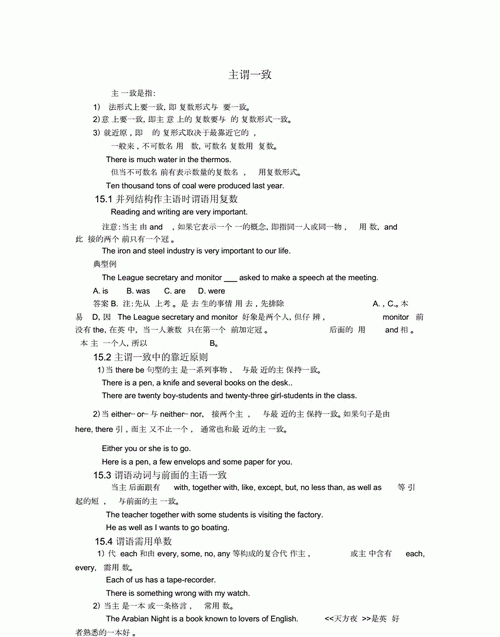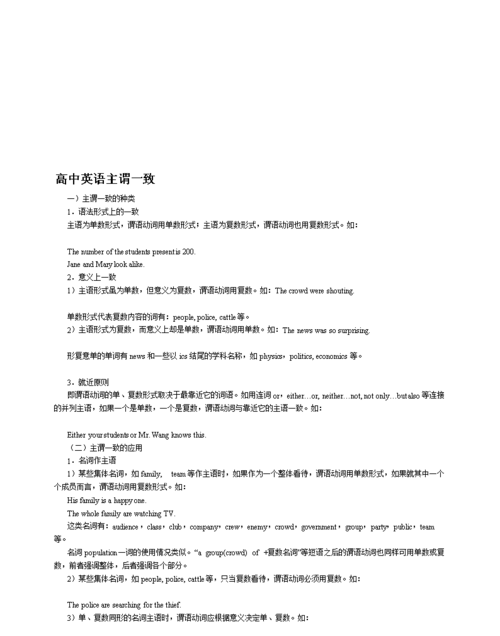本文目录
英语中的主谓一致性归纳
主谓一致的定义
主谓一致指的是主语和谓语在人称和数的方面取得一致的问题。
主语若是复数,谓语也采用复数形式。
主语若是单数或是不可数名词,谓语采用单数形式。
主谓一致的分类
主谓一致分为两大类:就近一致原则和意义一致原则。
就近一致原则指的是,以靠近谓语动词的,作主语的名词作为人称和数的参考标准。
意义一致原则指的是,必须分析主语属于单数或是复数,可数或是不可数,然后才能决定谓语动词的人称和数的形式。
就近一致原则(1)
连词not only...but also/ neither...nor/ or/ either...or/ not...but
<><><>
Not only the students but also the teacher is enjoying the film.
不仅学生而且老师都在津津乐道地看着电影。
Neither the students nor the teacher knows anything about it.
同学们和老师对此都一无所知。
Neither he nor they are wholly right.
他和他们,谁都不是完全对的。
Either he or I am right.
或者他对,或者我对。
就近一致原则(2)
副词here/ there
<><><>
Here comes the bus.
瞧,公共汽车来了。
Here is a pencil-box for you.
这儿有一个铅笔盒要给你。
Here are my replies to your questions.
这些是我针对你的问题的回答。
There is an apple, two bananas and some oranges on the plates.
盘子里有一个苹果,两条香蕉和一些桔子。
主谓一致:and
and的两边分别是不同的可数名词。
John and Mary are my friends.
约翰和玛丽都是我的朋友。
<><><>
and的两边分别是不同的不可数名词。
Both rice and wheat are grown in China.
中国有种水稻也有种小麦。
<><><>
and的两边的单词构成一个统一的概念。
Fish and chips is a popular supper here.
炸鱼土豆片在这里是一种很受欢迎的晚餐。(鱼和土豆片作为整体)
The poet and writer has come.
那位诗人兼作家来了。(同一个人既是诗人又是作家)
<><><>
each(every) + 单数名词 + and + each(every) + 单数名词
谓语动词用单数
Every hour and every minute is important.
每一小时,每一分钟,都很重要。
主谓一致:with...
“主语 + 后置定语”谓语动词只看主语,不看后置定语部分。
引起这种后置定语的单词有:
with, along with, together with, as well as, like, rather than, but,
except, besides, including, in addition to。
<><><>
The teacher with two students was at the meeting.
那位老师还有两个学生参加会议。
I as well as they am ready to help you.
不仅他们乐以帮助你,我也乐以帮助你。
A woman with two children is over there at the bus stop.
一个妇女还有两个孩子在公共汽车站那儿。
主谓一致:to do, doing
主语是由不定式、动名词、从句构成的,谓语动词采用单数。
To learn a foreign language is not easy.
It’s not easy to learn a foreign language.
学外语不容易。
Working with you is pleasant.
It’s pleasant working with you.
同你一块工作是令人愉快的。
The building whose roof we can see from here is a hotel.
我们从这儿就能看到屋顶的那座楼房就是旅馆。
主谓一致:police
police 警察/ militia民兵/ people人们/ vermin 害虫/ cattle 牲畜/ poultry 家禽
<><><>
这类集体名词的后面常接复数的谓语动词。
The police are questioning everyone in the house.
警察正在盘问房间里的每一个人。
Domestic cattle provide us with milk, beef, and hides.
家牛为我们提供牛奶、牛肉和皮革。
主谓一致:family
army军队/ data 数据/ jury 陪审团/ audience 观众/ enemy 敌人/ media 媒体
bacteria 细菌/ family 家庭/ navy 海军/ committee 委员会/ flock 羊群
nobility 贵族/ community 共同体/ firm 商号/ party 政党/ company 公司
gang 一群/ press 新闻界/ council 理事会/ government 政府/ public 公众
couple 对、双/ group 组/ staff 全体职员/ crew 全体人员/ herd 牧群/ team 队
<><><>
这类集体名词可以用作单数也可以用作复数。如果把"family"看成家庭成员,谓语用复数。如果把"family"看成一个整体,谓语用单数。
<><><>
His family are waiting for him.
他的家人正在等他。(把"family"看成家庭成员)
I've got to make it clear that my family was very poor.
我得说清楚,我的家是很穷的。(把"family"看成一个整体)
主谓一致:furniture
mankind 人类/ furniture 家具/ foliage 植物
clothing 衣服/ machinery 机械/ merchandise 货物
这类集体名词只能用作单数形式,因为它们属不可数名词。
<><><>
Our clothing protects us from cold.
衣服保护我们免受寒冻。
Then the furniture was moved in.
然后家具被搬进来。
主谓一致:trousers
glasses眼睛/ spectacles眼睛/ scissors剪刀/ shorts短裤/
trousers裤子/ pajamas睡衣
Where are my pajamas? 我的睡衣在哪里?
My trousers are too long. 我的裤子太长了。
<><><>
shoe鞋子/ glove手套/ sock袜子/
目前的教辅把shoes归入和trousers同一类,这样作对于高考没有大碍。不过两者的不同之处在以后的大学课堂中还需明辨。
主谓一致:the old
名词化的形容词作主语时要看主语的具体情况。
一. 看作复数
The wounded were sent home.
伤员被送回家。(指一批人,动词用复数。)
The old are taken good care of here.
这儿的老人受到很好的照顾。(一批人)
二. 看作单数
The true is to be distinguished from the false.
真假必须辨明。(抽象的概念,看成单数。)
The accused was punished to prison.
那个被告被判入狱。(一个人)
主谓一致:two years
时间、金钱、路程的名词
虽是用复数形式作主语,谓语动词仍然要用单数形式。
Two years is enough.
两年就够了。
A hundred miles is a long distance.
一百英里是一段很长的距离。
主谓一致:percent
分数和百分数的词作主语时,以“of 短语”中的名词为判断标准。
Thirty percent of the grain is used to feed animals.
百分之三十的粮食用来饲养牲口。
Ninety percent of the smokers are male.
百分之九十的吸烟者是男性。
主谓一致:each
以下列不定代词作主语的句子谓语动词用单数:
either, neither, each, one, the other, another, anybody, anyone, anything,
somebody, someone, something, everybody, everyone, everything, nobody,
no one, nothing(含有单数意义的不定代词)
<><><>
Neither of those men is wrong.
那两个人都没有错。
Each of the books costs ten dollars.
每一本书花费10美元。
Somebody is using the phone.
有人在用电话。

英语主谓一致的用法
谓一致是中学英语的一项重要语法内容,也是高考必考的语法点之一。虽然主谓一致涉及的语法规则有多条,但面临高考的同学应特别关注以下几点:
一、动词不定式短语、-ing形式短语或名词性从句作主语时,谓语动词一般用单数形式。但what引导从句作主语时,在下列情况下,主句谓语动词多用复数形式:①表语为复数名词时;②what引导的从句是一个具有复数意义的并列结构时。如:
Learning new words and useful expressions is very important for me.
What he’d like is a digital watch.
What we have to learn are the pieces of language that produce inversion.
What I say and think are no business of yours.
二、在定语从句中,关系代词作主语时,谓语动词的数常与其先行词保持一致。但在“one of +复数名词+定语从句”的结构中,从句的谓语常用复数形式;而在“the (only) one of +复数名词+定语从句” 的结构中,从句的谓语常用单数形式。试比较:
I was one of the persons in my office who were invited.
I was the(only) one of the persons in my office who was invited.
三、“分数/百分数+ of + 名词”作主语时,谓语动词的数要与of后面的名词保持一致。如:
Two-fifths of the land in that district is covered with trees and grass.
More than ten percent of the workers are from Paris.
四、由or,either...or...,neither...nor...,not only...but also...,not...but...等连接并列主语时,谓语动词的数通常遵循“就近一致”的原则,即谓语动词的单、复数形式依最接近它的主语而定。特别要注意疑问句中谓语动词的形式。如:
Either her father or her mother calls for her every afternoon.
- Are either you or he to go there ?
- Neither is.
Neither the president of the company nor the sales manager is a college graduate.
五、and / both...and...连接两个并列主语时,谓语动词一般用复数形式。若and连接的两部分指同一人、同一物、同一事或同一概念时,谓语动词则常用单数形式。如:
His lawyer and parents were with him on his trip to Europe.
Both rice and wheat are grown in our country.
Whisky and Soda is always my favorite drink.
(Whisky and Soda意为“威士忌汽水酒”,指同一物)
Your colleague and former college friend is coming to our home tomorrow.
(主语部分意为“你的同事,就是你那位大学时的朋友”,指同一人)
六、在each...and each...,every...and every...,no ... and no...,many a.../more than a(an, one)...等结构之后,谓语动词常用单数形式。如:
Every man and (every) woman is to take part in the election.
Many a child likes it.(=Many children like it.)
七、一些以-ics结尾的学科名词,如mathematics /politics / physics以及news/works(工厂)/means等在形式上似乎是名词的复数形式,但多用作单数名词,此类名词作主语时,谓语动词一般使用单数形式。如:
The paper works was built in 1990.
Every possible means has been used to prevent the air pollution, but the sky is still not clear.
八、一些“成双成套”的名词,如
trousers /pants /glasses /clothes /shoes /scissors/compasses(圆规)等用作主语时,谓语动词常用复数;若此类名词前有a (the/this) pair of /a suit of等量词修饰时,谓语动词则常用单数形式。如:
My glasses are broken. I have to buy a new pair.
The pair of shoes under the bed belongs to Tom.
九、若主语是由“a kind of/a series of等+名词”构成时,谓语动词通常用单数形式;但在“these/those kind/type of+复数名词”之后,谓语动词则常用复数形式。如:
This kind of men is dangerous.
These kind of tests are good.

英语中的主谓一致有哪些
主谓一致有三种情况,就近一致是其中的一种。这三种情况分别如下:
语法一致:指单数名词与表示单数概念的动词保持一致;复数名词与表示复数概念的动词保持一致。
概念一致:单数名词表示复数概念,如 people(人们)、cattle(牲畜)、family(全家人)等,要与表示复数概念的动词保持一致;复数名词表示单数概念,如 news(新闻),gymnastics(体操)、another six weeks(又一个六周)等,要与表示单数概念的动词保持一致。
就近一致:指动词与就近的主语一致。这种情况只有三种:
1)there be 后的并列主语;
2)or(包括either ... or 和 neither ... nor)连接的主语;
3)not only but also和连接的主语

主谓一致语法一致例句
1.人称、数的一致。 [2例句] I am a student . Two books are on the desk .2.不可数名词、不定代词表示抽象概念作主语时,谓语动词用单数。[1例句] there is little water in the bottle .3.主语为people , police,时,谓语动词用复数。[1例句] the police are searching the lost boy .4.集体名词family, class, team, group,等看作整体时,谓语动词用单数;看作每一个成员时,谓语动词用复数。[2例句] class four ins on the second floor. my family has moved to Beijing .5.与and连接的并列主语表示不同的人和物时,谓语动词用复数,表示一个概念时则用单数。[2例句] Tom and lilei are students. The artist and teacher is coming .6.主语是单数,后跟with,as well as, but ,except等介词短语时,谓语动词用单数。[1例句] Mr Green, together with his students is in the classroom.7.金钱、距离、时间、重量、长度等复数名词做主语,通常应当作整体看,谓语动词用单数。[1例句] Two days is not long.8.tousers、shoes、glasses等作主语,谓语动词用复数。[1例句] my tousers are on the desk .9.most of、 half of、 some of、 part of 、a lot of修饰名(代)词作主语时,谓语动词与of后面的名词或代词的数保持一致。[2例句]Half of the population are farmers. A lot of water is wasted.10.news, physics等词貌似复数,实为单数,作主语时,谓语动词用单数。[1例句]The news is true. 11.either… or… 与neither… nor,not only... but also...作主语时,谓语动词与离它们最近的名词或代词在人称和数上保持一致。[2例句] Not only he but also I am good at maths.Neither you nor he is going with him. 12there be 的谓语动词与离它们最近的名词或代词在人称和数上保持一致。[2例句] There is a pen ,two pencils and a book on the desk.There are two apples and a banana in the basket.

以上就是关于主谓一致短语英语 ,英语中的主谓一致性归纳的全部内容,以及主谓一致短语英语 的相关内容,希望能够帮到您。
